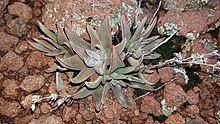Dudleya abramsii is a species complex of succulent plants native to California and parts of Baja California. There are numerous subspecies, some critically endangered, with varying habits and lifestyles, but most often characterized by a smaller size, yellow flowers, and an affinity for rocky habitats.[2] The subspecies may be polyphyletic.[3]
| Dudleya abramsii | |
|---|---|

| |
| subsp. abramsii | |
| Scientific classification | |
| Kingdom: | Plantae |
| Clade: | Tracheophytes |
| Clade: | Angiosperms |
| Clade: | Eudicots |
| Order: | Saxifragales |
| Family: | Crassulaceae |
| Genus: | Dudleya |
| Species: | D. abramsii
|
| Binomial name | |
| Dudleya abramsii | |
Description
editDudleya abramsii is a fleshy perennial forming a small basal cluster of leaves around a central caudex. The habit of Dudleya abramsii is growing in either solitary rosettes or in caespitose forms. The thick, glaucous leaves are lance-oblong to lanceolate, reaching up to 11 centimeters in length, but often remaining much smaller, usually 2 to 30 mm long, and 3 to 20 mm wide. The entire rosette is generally only 0.5 to 15 cm wide. The inflorescence is a mostly erect, branching stem lined with pointed bracts and bearing up to 15 flowers. The inflorescence has a peduncle 2 to 25 cm tall, and 1 to 6 mm wide. The lower bracts are 4 to 40 mm large, and the pedicels are anywhere from 0.5 to 7 mm long. The flower has five small, thick sepals at the base of five pale to cream yellow petals each roughly 8 to 13 mm long. The keel of the flower is tinged with fine, purple to red lines.[2]
Taxonomy
editThere are several subspecies, and many former subspecies with differing recognition. Flora of North America and The Jepson Manual have elevated Dudleya parva to a species, while other subspecies have been moved to Dudleya cymosa[2]
The following subspecies are recognized in the 2012 Jepson eFlora:
- Dudleya abramsii subsp. abramsii Rose (Abrams' liveforever) – native to the Peninsular Ranges of California and Baja California. Syn. Dudleya tenuis.
- Dudleya abramsii subsp. affinis K.M. Nakai (San Bernardino Mountains liveforever) – endemic to the San Bernardino Mountains near the edge of the Mojave Desert. Syn. Dudleya baldwinensis.
- Dudleya abramsii subsp. bettinae (Hoover) Bartel (San Luis Obispo serpentine dudleya or Betty's liveforever) – endemic to the coastal serpentine of San Luis Obispo County, California.
- Dudleya abramsii subsp. calcicola (Bartel & Shevock) K.M. Nakai (Limestone dudleya) – endemic to the southern Sierra Nevada. Syn. Dudleya calcicola
- Dudleya abramsii subsp. murina (Eastw.) Moran (San Luis Obispo or mouse-leaved dudleya) – endemic to coastal San Luis Obispo County
- Dudleya abramsii subsp. setchellii (Jeps.) Moran (Santa Clara Valley liveforever) – endemic to the Santa Clara Valley. Formerly classified under D. cymosa.
Distribution and habitat
editD. abramsii is native to California and northern Baja California, where it grows in rocky areas in a number of habitat types.[2]
References
edit- ^ "NatureServe Explorer 2.0".
- ^ a b c d McCabe, Stephen Ward (2012). "Dudleya abramsii". Jepson eFlora. Jepson Flora Project (eds.). Archived from the original on 2017-08-29. Retrieved 18 October 2021.
- ^ Yost, J. M.; Bontrager, M.; McCabe, S. W.; Burton, D.; Simpson, M. G.; Kay, K. M.; Ritter, M. (2013). "Phylogenetic relationships and evolution in Dudleya (Crassulaceae)" (PDF). Systematic Botany. 38 (4): 1096–1104. doi:10.1600/036364413X674760. S2CID 15715233.
- Best, Troy L. (2007). "INDEX TO VOLUME 52". The Southwestern Naturalist. 52 (4): 630–645. doi:10.1894/0038-4909(2007)52[630:ITV]2.0.CO;2 (inactive 1 November 2024). ISSN 0038-4909.
{{cite journal}}: CS1 maint: DOI inactive as of November 2024 (link)
